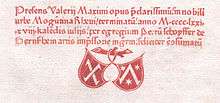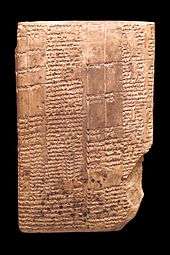Colophon (publishing)
In publishing, a colophon (/ˈkɒləfən, -fɒn/)[1] is a brief statement containing information about the publication of a book such as the place of publication, the publisher, and the date of publication. A colophon may also be emblematic or pictorial in nature. Colophons were formerly printed at the ends of books, but in modern works they are usually located at the verso of the title-leaf.

History
The term colophon derives from the Late Latin colophōn, from the Greek κολοφών (meaning "summit" or "finishing touch").[2] It should not be confused with Colophon, an ancient city in Asia Minor, after which "colophony", or rosin (ronnel), is named.
The existence of colophons can be dated back to antiquity. Zetzel, for example, describes an inscription from the 2nd century A.D., transmitted in humanistic manuscripts. He cites the colophon from Poggio's manuscript, a humanist from the 15th century:[3]
Statili(us) / maximus rursum em(en)daui ad tyrone(m) et laecanianu(m) et dom̅ & alios ueteres. III.
(‘I, Statilius Maximus, have for the second time revised the text according to Tiro, Laecanianus, Domitius and three others.’)
Colophons can be categorized into four groups.[4] Assertive colophons provide the contextual information about the scribe and manuscript. Expressive colophons demonstrate the scribe's feelings and wishes. Directive colophons make the reader do something, and the declarative colophons do something with the reader.
Examples of expressive colophons:
Finit dicendo: Ludid. Quicunque scriptor scribit / Leti ut scribunt scribae.
("He finishes saying, “Every scribe who writes has fun, for writing scribes are happy ones”.)
"I have made an end at last, and my weary hand can rest."[5]
Example of directive colophons:
O beatissime lector, lava manus tuas et sic librum adprehende, leniter folia turna, longe a littera digito pone.
("O most gracious reader, wash your hands and touch the book only like this: turn the pages softly and keep your finger far away from the text".)
Example of directive and declarative colophons:
Si quis et hunc sancti sumit de culmine galli / Hunc Gallus paulusque simul dent pestibus amplis
("If anybody takes this book from Gall’s estate, Gall and Paulus together shall inflict the plague upon him".)[3]
The term is also applied to clay tablet inscriptions appended by a scribe to the end of an Ancient Near East (e.g., Early/Middle/Late Babylonian, Assyrian, Canaanite) text such as a chapter, book, manuscript, or record. The colophon usually contained facts relative to the text such as associated person(s) (e.g., the scribe, owner, or commissioner of the tablet), literary contents (e.g., a title, "catch phrases" (repeated phrases), or number of lines), and occasion or purpose of writing. Colophons and catch phrases helped the reader organize and identify various tablets, and keep related tablets together. Positionally, colophons on ancient tablets are comparable to a signature line in modern times. Bibliographically, however, they more closely resemble the imprint page in a modern book.
Examples of colophons in ancient literature may be found in the compilation The Ancient Near East: Supplementary Texts and Pictures Relating to the Old Testament (2nd ed., 1969).[6] Colophons are also found in the Pentateuch, where an understanding of this ancient literary convention illuminates passages that are otherwise unclear or incoherent. Examples are Numbers 3:1, where a later (and incorrect) chapter division makes this verse a heading for the following chapter instead of interpreting it properly as a colophon or summary for the preceding two chapters, and Genesis 37:2a, a colophon that concludes the histories (toledot) of Jacob.
An extensive study of the eleven colophons found in the book of Genesis was done by Percy John Wiseman.[7] Wiseman's study of the Genesis colophons, sometimes described as the Wiseman hypothesis, has a detailed examination of the catch phrases mentioned above that were used in literature of the second millennium B.C. and earlier in tying together the various accounts in a series of tablets.
Printed books
_to_the_printed_copy_of_the_Diamond_Sutra%2C_(_Dunhuang).jpg)
_-_20140816.jpg)
In early printed books the colophon, when present, was a brief description of the printing and publication of the book, giving some or all of the following data: the date of publication, the place of publication or printing (sometimes including the address as well as the city name), the name(s) of the printer(s), and the name(s) of the publisher(s), if different. Sometimes additional information, such as the name of a proofreader or editor, or other more-or-less relevant details, might be added. A colophon might also be emblematic or pictorial rather than in words.[2] The normal position for a colophon was after the explicit (the end of the text, often after any index or register). After around 1500 these data were often transferred to the title page, which sometimes existed in parallel with a colophon.
Colophons sometimes contained book curses, as this was the one place in a medieval manuscript where a scribe was free to write what he wished. Such curses tend to be unique to each book.[9]
In Great Britain colophons grew generally less common in the 16th century. The statements of printing which appeared (under the terms of the Unlawful Societies Act 1799)[10] on the verso of the title-leaf and final page of each book printed in Britain in the 19th century are not, strictly speaking, colophons, and are better referred to as "printers' imprints" or "printer statements".
In some parts of the world, colophons helped fledgling printers and printing companies gain social recognition. For example, in early modern Armenia printers used colophons as a way to gain "prestige power" by getting their name out into the social sphere.[11] The use of colophons in early modern Armenian print culture is significant as well because it signalled the rate of decline in manuscript production and scriptoria use, and conversely the rise and perpetuation of printing for Armenians.
With the development of the private press movement from around 1890, colophons became conventional in private press books, and often included a good deal of additional information on the book, including statements of limitation, data on paper, ink, type and binding, and other technical details. Some such books include a separate "Note about the type", which will identify the names of the primary typefaces used, provide a brief description of the type's history and a brief statement about its most identifiable physical characteristics.
Some commercial publishers took up the use of colophons, and began to include similar details in their books, either at the end of the text (the traditional position) or on the verso of the title-leaf. Such colophons might identify the book's designer, the software used, the printing method, the printing company, the typeface(s) used in the page design and the kind of ink, paper and its cotton content.[12] Book publishers Alfred A. Knopf, the Folio Society and O'Reilly Media are notable for their substantial colophons.
Websites
Some web pages also have colophons, which frequently contain (X)HTML, CSS, or usability standards compliance information and links to website validation tests.[13]
See also
References
- "colophon". Merriam-Webster Dictionary. Retrieved 3 February 2019.
- James A[ugustus] H[enry] Murray, ed. (1888–1893). "colophon, n.". The Oxford English Dictionary: A New English Dictionary on Historical Principles Founded Mainly on the Materials Collected by the Philological Society [Vol. II, C–Czech]. Oxford: Clarendon Press. OCLC 460661449.
- Schiegg, Markus (2016). "Scribes' Voices: The Relevance and Types of Early Medieval Colophons". Studia Neophilologica. Taylor & Francis, The British Library Board. 88 (2): 129–147. ISSN 0039-3274.
- Schiegg, Markus (2016). "Scribes' Voices: The Relevance and Types of Early Medieval Colophons". Studia Neophilologica. British Library Document Supply Centre Inside Serials & Conference Proceedings. EBSCOhost: Sweden: Taylor & Francis. 88 (2): 129–147. ISSN 0039-3274.
- Murray, Stuart (2009). The Library: An Illustrated History. New York, NY: Skyhorse Publishing. p. 58. ISBN 9781628733228.
- James B[ennett] Pritchard, ed. (1969). The Ancient Near East: Supplementary Texts and Pictures Relating to the Old Testament: Consisting of Supplementary Materials for The Ancient Near East in Pictures and Ancient Near Eastern Texts (2nd ed.). Princeton, N.J.: Princeton University Press. pp. 101, 305, 331, 338, 340, and 341. OCLC 876082348.
- P[ercy] J[ohn] Wiseman (1985). D. J. Wiseman (ed.). Ancient Records and the Structure of Genesis: A Case for Literary Unity. Nashville, Tenn.: Thomas Nelson Publishers. ISBN 978-0-8407-7502-3. The book was originally published as P[ercy] J[ohn] Wiseman (1936). New Discoveries in Babylonia about Genesis. London; Edinburgh: Marshall, Morgan & Scott. OCLC 878558981.
- John Fortescue (1567). A Learned Commendation of the Politique Lawes of Englande: VVherin by moste Pitthy Reasons & Euident Demonstrations they are Plainelye Proued Farre to Excell aswell the Ciuile Lawes of the Empiere, as also all other Lawes of the World, with a Large Discourse of the Difference betwene the. ii. Gouernements of Kingdomes: Whereof the One is onely Regall, and the Other Consisteth of Regall and Polityque Administration Conioyned. Written in Latine aboue an Hundred Yeares Past, by the Learned and Right Honorable Maister Fortescue Knight, Lorde Chauncellour of England in the Time of Kinge Henrye the. vi. And Newly Translated into Englishe by Robert Mulcaster (1st English ed.). London: In Fletestrete within Temple Barre, at the signe of the hand and starre, by Rychard Tottill. OCLC 837169265.
- Cynthia J. Cyrus (2009), The Scribes for Women's Convents in Late Medieval Germany, Toronto, Ont.: University of Toronto Press, p. 162, ISBN 978-1-4426-8908-4. See also Dawn Rae Downton (2013), The Little Book of Curses and Maledictions for Everyday Use, New York, N.Y.: Skyhorse Publishing, ISBN 978-1-60239-741-5; and for fictional treatment, see Edgar J[ohnson] Goodspeed (1935), The Curse in the Colophon, Chicago, Ill.: Willett, Clark, & Company, OCLC 2599686.
- Unlawful Societies Act 1799 (39 Geo. 3, c. 79).
- Sebouh D. Aslanian. (2014). Port Cities and Printers: Reflections on Early Modern global Armenian Print Culture, Book History 17, 60.
- See, for example, Stephen Wolfram (2002). A New Kind of Science. Champaign, Ill.: Wolfram Media. p. 1264. ISBN 978-1-57955-008-0.
- Some examples include: "Colophon". Web Standards Project. Archived from the original on 3 July 2014. Retrieved 18 August 2014. "Colophon". Wittenberg University. Archived from the original on 26 July 2014. Retrieved 18 August 2014.
Sources
| Wikimedia Commons has media related to Colophons. |
| Look up colophon in Wiktionary, the free dictionary. |
| Wikisource has the text of a 1911 Encyclopædia Britannica article about Colophon. |
- Friedl, Friedrich; Ott, Nicolaus; Stein, Bernard (1998). Typography: An Encyclopedic Survey of Type Design and Techniques throughout History. New York, N.Y.: Black Dog & Leventhal. ISBN 978-1-57912-023-8.
- Glaister, Geoffrey Ashall (1979). Glaister's Glossary of the Book: Terms Used in Papermaking, Printing, Bookbinding, and Publishing, with Notes on Illuminated Manuscripts and Private Presses (2nd rev. ed.). London: G. Allen & Unwin. ISBN 978-0-04-010006-9.
- Hamilton, Victor P. (1990). The Book of Genesis: Chapters 1–17. Grand Rapids, Mich.: William B. Eerdmans Publishing Company. pp. 5–6. ISBN 978-0-8028-2308-3.
- Pollard, Alfred W. [1905]. An Essay on Colophons: with Specimens and Translations at Project Gutenberg
